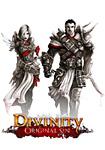
Original Sin & Dragon Commander - Previews @ RPGCodex
RPGCodex have their previews of Original Sin and Dragon Commander online based on their visit to Larian Studios.
As enjoyable as the combat is though, most of the fun came from the exploration of the world. Swen told me that this game is a return to their roots and it is obvious after a couple of minutes. Forget the extended dungeon crawl of Beyond Divinity or the somewhat limited maps of Divinity 2, this time it's a big seamless world like in Divine Divinity. One returning feature is the distinct lack of loading screens, so cities, villages, dungeons, caves, beaches, forests, cliffs and other assorted locations are all part of the same big map. It's amusing how much this widens the scope of the world, and yet you likely won't notice it because it feels so natural. In my case it only hit me when Swen jokingly asked me if I had counted the loading screens since we started playing and I realise that I had seen none apart from when we started. That he was proud of this was evident. They couldn't avoid loading screens entirely, and so far the game counts 4 big maps, but that's far less than what most games do these days, as D:OS isn't limited by console hardware. He laughed when I shared with him that when I played Divine Divinity for the first time, I naively thought that I'd explore the whole map outside of Aleroth and then go to bed — for those who never played the game, exploring the whole map took me around a week and that was back when I had a lot of free time to play.
And on Dragon Commander:
Once you're done with the conversations and other social interactions, you will discover that there is a whole new game for you to play with. The strategic map is where you plan out your battles and it has a nice board game feel to it — I'll also add that I love the illustrations of marine monsters in the sea zones of the map. While it does not look like it, every region is in fact a hex in disguise and the map wraps on itself, à la Solium Infernum, which means that you are always in the middle of the board and so are your opponents. The map isn't fixed and, just like in Civilization, you can choose the size of the map when starting a new game, thus allowing you to set the length of the campaign according to your preference, or you can pick one of the pre-made maps available. This also applies to the multiplayer. Since the Raven is not available in multiplayer, the strategic map is also where you'll pick your upgrade and research objectives. Each region you own has a population value and also brings you some gold each turn. Population is the reserve from which you build your army in the RTS phase, but since it is a shared resource this means that everyone involved in a fight will draw from it. The higher the population, the more units each player will be able to build in the RTS mode. That's where cards that let you play with the population numbers come in handy: increasing the population means that you will be able to create more units during the battle, but so will your opponents; on the contrary, by imposing a genocide that will leave the country empty, you make initial invading and defending armies more important since nobody will be able to create new units. Other cards can be very useful as well, like increasing the revenues of a region by 200%, increasing productions, reducing the price of units, or even simply but effectively making one of your countries immune to invasion.
Information about
Original SinSP/MP: Single + MP
Setting: Fantasy
Genre: RPG
Platform: PC
Release: Released

